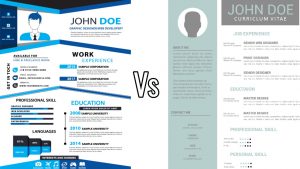Differences between Resume and CV (Curriculum Vitae): It is often wondered, especially among job seekers, if there really is any difference between a CV and a resume. Is one just a synonym for the other and can they used interchangeably? Or do they have distinct meanings and functions? What does this mean for job seekers? Why do some job seekers make job applications using a resume and others a CV? How does one know when to use which?
It is pertinent to understand that both documents are meant for job applications, should adequately represent you as the best candidate for the job and should get you interviewed. Also, which of them you’d use in your application, or whether you’d even use both, depends on the company you’re applying to.
The intent behind this article is to clear the air about CVs and resumes and lay the confusion to rest.

Recommended: Cheapest Cities in the United States 2021: Top 10 Most Affordable
Whats is a CV?
CV, or Curriculum Vitae is a Latin word which translates to ‘course of life‘. It is a lengthy and detailed document often used in application for positions in grants, fellowships, etc.

It can run from three to over ten pages in length and contains in detail all educational activities and achievements of a person within the duration of his career. It includes degrees and certifications, publications including thesis and dissertations, academic honors and awards, etc.
Things one can include in a CV are;
Contact details, conferences and seminars attended, teaching experience, research experience, references, professional appointments, academic awards, certifications, etc.
Recommended: Differences between a deed and an agreement
What is a Resume?
Résumé means ‘summary‘ in French. Details entered in a resume should lay greater emphasis on the skills of the candidate than anything else. Educational qualification is usually placed at the tail end of the document.

Resumes are short, brief and concise. They generally do not exceed two pages in length. They are mainly used to apply for positions in non-profit organizations, industries and factories and in some cases, the public sector, where more skill than academic qualification is required.
Also see: Tips for drafting a good affidavit
Differences between CV And Resume
The first notable difference between a CV and a resume is the length. Curriculum Vitae is way lengthier than a resume. This is because it contains an extensive representation of information, usually on the applicant’s educational or academic background. A resume on the other hand is shorter, concise, straight-to-the-point, summarized and brief.
Secondly, Curriculum Vitae contains information about ones academic achievements; that is, it is mainly composed of one’s credentials. Any academic memberships or affiliations, research work or experience, education grants, certifications and degrees are to be noted in a CV, including details of when and here these achievements were made. On the other hand, resumes are competency or skill-based. This means that what is recorded on your resume, or what a potential employer should expect to see on it is a record of your practical knowledge including your skills, work experience especially as related to the job being applied for and any other related experience.
It follows that since CVs are basically a compilation of academic achievements, it is mostly used to apply for education-related positions. Application for consideration for grants, fellowship membership, post-degree positions, professorship, teaching positions in basic/secondary schools and institutions of higher learning. As a matter of fact, some postgraduate programmes require candidates to make their applications with a CV, especially if you’re applying for a programme in an international University.
Resumes are rather used for other jobs which require more skills that educational prowess. It doesn’t means that resumes should not contain any educational qualification or certification of the candidate at all, it only means it should be limited and focus more on the candidate’s skills.
Both documents are often used interchangeably in many settings, with no distinction in their functions. In other cases, the difference in function is recognised and companies demand from candidates only the one they require. There are also other settings where both are required by the employers, especially if the position requires both skill and educational qualification.
Before we move to the next subheading, I highly recommend that you watch the YouTube video below for more points on the differences between a Curriculum Vitae and a Resume. Trust me, you won’t regret it.
Recommended: Differences between note-taking and note-making
Tips for writing a CV and Resume
Now that we have noted and understood the differences between a CV and a resume, we all need to come to the understanding that despite all of that, both documents are used for job applications. Therefore, the end goal when writing any of them would be to convince the potential employer that you are the best candidate for the job, show him that you’re qualified and what value you can offer to the organization or company.
In lieu of this, here are some rules or tips you should observe in writing your CV or resume that would make it outstanding and catch the eye of the potential employer. Writing a wonderful application puts your foot in the door in being a successful candidate.
1. Know What Comes First With Either Document
It all depends on the position you’re applying for. If it is an educational position you’re applying for i.e a teaching job, you might want to use a CV, and in addition, make your educational experience top on the list of qualifications. If you’re applying for non-academic position, then you should use a resume. Endeavour to mention your work experience or skillset which relates to the job you are applying for at the very top of the list.
Doing this would show the hiring manager that you understand the job description and have the ability and qualification to handle the tasks that come with the job.
Recommended: Advantages and Disadvantages of Alternative Dispute Resolution (ADR)
2. Uniformity Is Key
If your document is not uniformly compiled, you are sending a red flag signal to the potential employer. No one wants to hire a disorganized candidate because it tends to breed incompetency and inefficiency. To avoid being labeled unwanted candidates, ensure to use a uniform format in organizing your CV or resume. If you’re numbering your qualifications, then number then to the end. If you’re using bulle points, then use it all through. Highlight your heading and subheadings and align them properly. If your document is not arranged, it already sends a message to the employer that you are not fit for the job.
3. Templates Are Your Friend
You could know all that you need to include in your CV or resume, but you still need to arrange them using a certain format before they are ready to be sent out for application. Templates are very useful in this case. They provide a structure that one can follow in bringing their CV or resume to life.
Simply download a template online and follow the format provided. Alternatively, you can download several templates and compare them, then use whichever appeals to you or whichever suits the particular document you’re compiling or the job you’re applying for.
Also see: How to dress corporate as a guy
4. Clean Up Your Work
It doesn’t matter which one of the documents you’re using – whether it’s a CV or resume – you need to ensure that you thoroughly proofread and edit your work. These documents are for professional purposes, and therefore, it should look the part. Ensure that there are no grammatical or typographical errors in it, and that you use proper spelling.
5. Remember That The Format For Each Document Differs
The format for a CV and resume are not the same. Remember this when downloading templates to help create your own version. Do not use the same format for both documents; the one which you used the wrong template for would turn out unprofessional.
Also see: How to prepare for an interview and pass excellently
Conclusion
So far we have discussed the meaning, differences and tips for writing a CV and Resume excellently. I believe that you can clearly differentiate between a resume and a CV to someone who doesn’t know their differences. Coupled with that, with what I have explained above, you can draft a good cv or resume that is capable of helping you get employed.

Edeh Samuel Chukwuemeka, ACMC, is a lawyer and a certified mediator/conciliator in Nigeria. He is also a developer with knowledge in various programming languages. Samuel is determined to leverage his skills in technology, SEO, and legal practice to revolutionize the legal profession worldwide by creating web and mobile applications that simplify legal research. Sam is also passionate about educating and providing valuable information to people.